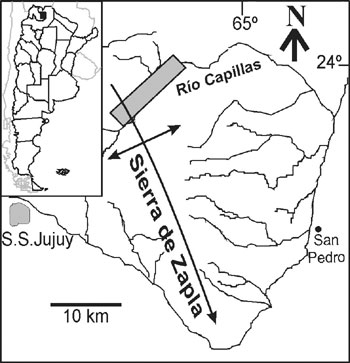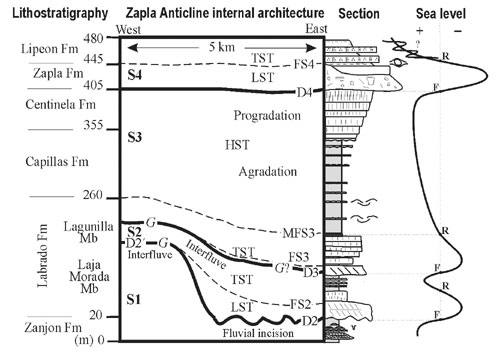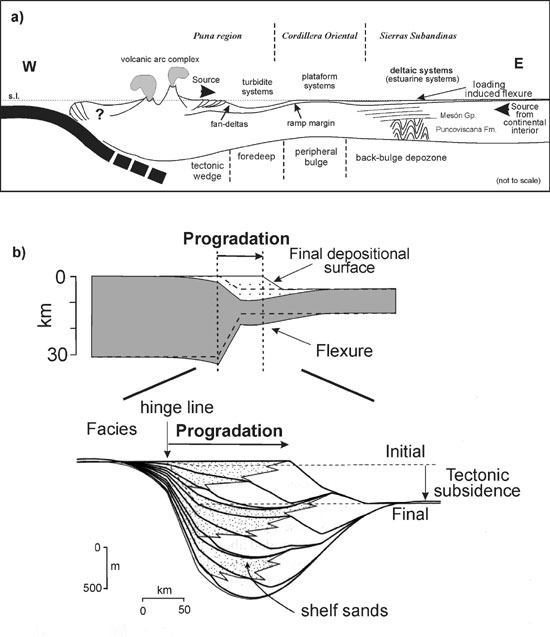
The Ordovician stratigraphy of the Sierras Subandinas (Subandean Ranges) in Northwest Argentina and its bearing on an integrated foreland basin model for the Ordovician of the Central Andean Region
Ricardo A. Astini1–2, Larisa Marengo1 and Claudia V. Rubinstein 2–3
1 Estratigrafía y Geológía Histórica, Universidad Nacional de Córdoba, V. Sarsfield 299, 5000 Córdoba, Argentina. E–mail: raastini@efn.uncor.edu
2 CONICET
3 Unidad de Paleopalinología, IANIGLA, CRICYT, 5500 Mendoza, Argentina.
Key words: Back–bulge stratigraphy. Foreland basin systems. Ordovician. Sierras Subandinas. NW Argentina.
Introduction
An integrated approach to the Ordovician basin of NW Argentina
Ordovician rocks are superbly exposed in the Central Andean basin. This area is regarded as one of the most spectacular in the world for the study of Gondwanan Ordovician sequences, showing thickness of >5000 m and continuous exposures of thousands of square kilometers. However, because of their apparent monotony they have not been properly studied. In Argentina, the stratigraphy of the Puna region, the Cordillera Oriental, the Sierras Subandinas and the Sierras de Santa Bárbara, as well as the one known from the subsurface in the Chaco plains is embraced within the so–called northwest basin. Traditionally all these "basins" have been regarded as separate, mainly because of the influence of most recent Cenozoic partition and upon usage of present–day –Andean derived– morphostructural criteria. No substantial stratigraphic argument has been provided to separate the Ordovician sedimentary history of these five present–day different geological provinces. Most of the misleading arguments to separate these regions during the Ordovician have been related to subtle paleontological differences, important lithological contrasts and localized unconformity development. All of these can easily be explained when considering a continuous link of depositional settings (including onshore–offshore gradients) and the gradual changes that occur across a foreland basin. This framework should not be regarded as fixed in space or time. On the contrary, present day foreland models suggest a dynamic setting with various different stratigraphic responses across– and along–strike that allow understanding the differential behavior to variable causes and their timing (e.g., Quinland and Beaumont, 1984; Flemings and Jordan 1989, 1990; Jordan and Flemings, 1991; Sinclair et al., 1991; Slingerland et al., 1994; Crampton and Allen, 1995; DeCelles and DeCelles, 2001; Cardozo and Jordan, 2001). This view provides not only a good answer to the previous outlined differences, but also allows integration of various previously regarded as disconnected features across the Ordovician System of northwest Argentina. The first to suggest a link between the different depositional systems represented in northwest Argentina with a modern perspective was Bahlburg (1990, 1991). In his work, he raised the possibility of explaining some of the major differences between these "basins" by applying a foreland basin model. Present–day knowledge allows refinement of the suggested foreland basin systems (cf. DeCelles and Giles, 1996) in the light of a wealth of new data and the better constrains for the flexural response in the Cordillera Oriental (Eastern Cordillera) and to the east. Also, previous models have considered sedimentary dispersal to the foredeep largely derived from the western Puna arc (resulting from progressive unroofing of either the volcanic–arc loads in the "Arc Scenario" or the orogenic wedge in the "Tectonic Scenario" of Bahlburg and Furlong, 1996). However, there is now enough evidence to support a doubly feed system with a second extremely important input from the east, related to major deltaic complexes source from the craton (Astini and Waisfeld, 1993; Astini and Marengo, 2003). These deltas contributed to additional loading and active flexure within the back–bulge depozone, independent from the loading–unloading stages that occurred in the arc to the west (Bahlburg and Furlong, 1996) and may have been, in turn, controlled by far–inland climate, comparable to development of the Mississippi Fan. Loading–unroofing stages have been regarded as responsible for triggering the flexural response in the foredeep (broadly coincident with the Puna region) and in the forebulge (broadly coincident with the Cordillera Oriental) (Bahlburg and Furlong, 1996).
Herein, we present a chronologically constrained 2D stratigraphy that documents important changes in the stratigraphic record of the Ordovician successions in the Sierras Subandinas of Argentina and provide new elements to interpret back–bulge evolution. Our results allow establishing correlations to the north, south and to the west, were some key–surfaces can be correlated into the Cordillera Oriental.
Ordovician stratigraphy in the Sierras Subandinas
Best and most complete Ordovician section across the Sierras Subandinas crops out along the Río Capillas (Monaldi et al., 1986), Sierra de Zapla (Jujuy Province) (Figure 1). From bottom to top the stratigraphy (~1000 m thick) is as follows (Figure 2): a) Zanjón Formation with non exposed base, (middle–late Arenig), b) Labrado Formation divided into the Laja Morada Member (late Arenig) and the Lagunillas Member (early–middle Llanvirn), c) Capillas Formation (late Llanvirn–basal Caradoc), d) Centinela Formation (not older than late Caradoc) and e) Zapla Formation (Hirnantian). The Lipeón Formation is Silurian and initiates a separate supercycle. Chronostratigraphy is palynologically controlled (e.g., acritarchs, prasinophytes, chitinozoans and cryptospores) and, some units have an independent biostratigtraphic control (Sánchez et al., in press).

Figure 1. Location map of the study area showing the Zapla anticline in the Sierras Subandinas, northwest Argentina.
Four 3rd order sequences (S1–S4) with different internal arrangements were recognized throughout (Figure 2). The Zanjón Fm. conforms S1, exposed at base of the section (Figure 2), and characterized by tidal parasequences that shallow–up into hetherolithic and muddy intervals with Skolithos and Cruziana ichnofacies (IF). Subaerial exposure features include truncated ripples and mud–cracks. Toward the top, mottling and gradual change into purple–red colors (Laja Morada Mb) represent exhumation during relative sea–level drop, indicating extensive exposure and water table fluctuation in interfluves. A sharp irregular erosive boundary (D2) separates S1 from S2. Coarse unsorted trough–cross–bedded sandstones overlies D2. Five kilometers to the west, D2 correlates with a subtle thin interval of pebbly sandstones overlying a surface (D2') affected by Glossifungites IF (G). Surface D2–D2' is interpreted as a sequence boundary showing lateral variations away from the paleovalley axis. S2 comprises a lowstand, and a transgressive systems tracts represented, respectively by sandy fluvial to tide–dominated estuarine fill and by subtidal thoroughly–bioturbated hetherolithic rocks. A new second sequence boundary is represented by D3 located at the base of the sandy Lagunillas Member. S3 is the most complete sequence in including the highstand systems tract. D3 shows well–developed Glossifungites IF being interpreted as firm grounds recording an interfluve sequence boundary, where the by–pass surface carved during the non–incisive fluvial stage merges with the transgressive flooding surface. Sandstones above D3 have a coarse lag at the bottom succeeded by cross sets with profuse tidal bundles. A flooding surface (FS3) separates the veneer sandstones from a thoroughly bioturbated (Skolithos IF) hetherolithic–mixed sandy package taken to represent subtidal facies. This is interpreted as a tidal ravinement surface due to backstepping and landward migration of sandy tidal inlets. A maximum flooding surface (MFS3) constitutes the boundary between the Labrado Fm. (Lagunillas Mb) and the Capillas Fm. This surface is of regional extent (traceable into the Cordillera Oriental, base of Santa Gertrudis Fm./Sepulturas Fm. and into the Santa Barbara Ranges). It separates restricted estuarine facies from open marine deposits. S3 evolves into aggrading– and prograding–stage highstand systems tracts, showing a clear thickening–coarsening trend. The thick–bedded bioturbated sandstones at the top of S3 are equivalent to the Centinela Fm. and relate to a prograding deltaic complex. S3 is truncated by a regional unconformity (D4) that involves erosion and reworking of the underlying stratigraphy. D4 is correlated with a major eustatic sea–level drop associated with the Hirnantian ice cap waxing stage that rapidly spread across Gondwana. The Zapla glacial horizon (S4) overlies D4 and in turn is drown by FS4. This initiates a separate supercycle with the deposition of several basin–wide oolitic ironstones that record high–frequency sea–level fluctuations. These economic deposits in the base of the Lipeón Fm. are interpreted as related to repeated transgressive–ravinement surfaces that truncate Fe+2–saturated estuaries after glacial waining and isostatic rebound.
According to the outermost position in the foreland basin systems context, the stratigraphy of the Sierras Subandinas and Santa Bárbara would record back–bulge depozone dynamics (Figure 3). Alternation of shallow–marine deltaic systems and estuarine environments indicate frequent coastal plain conversions induced by relative sea–level fluctuations. However, even considering the various erosive unconformities, the overall arrangement allows interpreting an important loading, capable to increase the predicted flexure by construction of a deltaic complex (e.g., Watts, 2001:150). This hypothesis (Figure 4) would explain the accommodation space required for development of the Centinela Formation, which has no equivalent to the west, but is apparently recorded to the north into Bolivia, where it has been tentatively correlated with the San Benito Formation (Suárez–Soruco and Benedetto, 1996).

Figure 2. Ordovician stratigraphy of both flanks of the Zapla anticline, recognized sequences and sea–level curve. Lithologies boundaries and names of units are described in the text. Thickness are minimum recorded.

Figure 3. A. Framework of Ordovician basins across northwest Argentina as part of foreland basin systems. B. Subsidence is assumed to increase with time about a fixed "hinge line". Modeled progradation advances a distance of around 150 km. A similar model is suggested for the development of flexure in the back–bulge region of the extended Ordovician foreland basin systems in northwest Argentina.
Conclusions
Prograding deltaic complex with frequent inversions to estuarine–dominated stages would have exerted fundamental control on back–bulge subsidence allowing to accommodate a relatively thick stratigraphy, not predicted by available foreland models. Dynamic interactions between sedimentary rates and sea–level change governed the Ordovician stratigraphy now preserved along the Sierras Subandinas and in the subsurface toward the Chaco plains.
One important conclusion of the integrated foreland basin systems model (Figure 3) is that even far behind the arc, in this peri–Gondwanan central Andean basin, the relative importance exerted by arc load– or tectonically–induced flexure will commonly hinder global signatures and hence, eustatic sea–level change variable has to be used with extreme care. Only in the Sierras Subandinas–Santa Bárbara, inferred as the back–bulge depozone, unconformities can be interpreted as a response of global sea–level signal. However, even there detail analysis has to consider load–induced subsidence and sedimentary rates as important factors controlling stratigraphic development.
Regarding the northwest basin as linked depozones in a foreland basin system (Figure 3) and simplifying the existing nomenclature allows better understanding of Western Gondwana depositional evolution.
References
Astini, R.A. and Waisfeld, B.N., 1993. Análisis estratigráfico y paleoambiental del Ordovícico medio (Formación Acoite y Sepulturas) en el borde occidental de la Cordillera Oriental jujeña. 12º Congreso Geológico Argentino y 2º de Exploraciones de Hidrocarburos, Tomo I: 96–106. Mendoza
Astini, R.A. and Marengo, L., 2003. Sequence Stratigraphy Of Perigondwanic Ordovician Clastics At The Outermost Reach Of The Protoandean Foreland, Sierras Subandinas, Argentina. 3º Latin American Congress of Sedimentology. Extended Abstracts Volume.
Bahlburg, H., 1990. The Ordovician basin in the Puna of NW Argentina and N Chile: geodynamic evolution from back–arc to foreland basin. Geotekt. Forsch., 75: 1–107.
Bahlburg, H., 1991. The Ordovician back–arc to foreland successor basin in the Argentinian–Chilean Puna: tectono–sedimentary trends and sea–level changes. In: D. Macdonald (Ed.), Sedimentation, Tectonics and Eustasy: Processes and Products: Special Publication International Association of Sedimentologists, Blackwell Scientific Publications, 1: 465–484.
Bahlburg, H. and Furlong, K.P., 1996. Lithospheric modeling of the Ordovician foreland basin in the Puna– NW Argentina: On the influence of arc loading on foreland basin formation. Tectonophysics, 259: 245–258.
Cardozo, N. and Jordan, T.E., 2001. Causes of spatially variable tectonic subsidence in the Miocene Bermejo foreland basin, Argentina. Basin Research, 13: 335–357.
Crampton, S.L. and Allen, P.A., 1995. Recognition of forebulge unconformities associated with early stage foreland basin development: Example from North Alpine foreland basin. American Association of Petroelum Geologists, 79: 1495–1514.
DeCelles, P.G. and Giles, K.A., 1996. Foreland basin systems. Basin Research, 8: 105–123.
DeCelles, P.G. and DeCelles, O.C., 2001. Rates of shortening, propagation, underthrusting, and flexural wave migration in continental orogenic systems. Geology, 29: 135–138.
Flemings, P.B. and Jordan, T.E., 1989, A Synthethic stratigraphic model of foreland basin development. Journal of Geophysical Research, 94: 3851–3866.
Flemings, P.B. and Jordan, T.E., 1990, Stratigraphic modeling of foreland basins: interpreting thrust deformation and lithosphere rheology. Geology, 18: 430–434.
Forsythe, R.D., Davidson, J., Mpodozis, C. and Jesinkey, C., 1993. Lower Paleozoic relative motion of the Arequipa block and Gondwana; paleomagnetic evidence from Sierra de Almeida of northern Chile. Tectonics, 12: 219–236.
Jordan, T.E., 1995. Retroarc foreland and related basins. In: Spera, C.J. and Ingersoll, R.V. (Eds.), Tectonics of Sedimentary Basins, Blackwell Science, Oxford, 331–336.
Jordan, T.E. and Flemings P.B., 1991. Large scale stratigraphic architecture, eustatic variations, and unsteady tectonism: a theoretical evaluation. Journal of Geophysical Research, 96: 6681–6699.
Monaldi, C.R., Boso, M.A. and Fernández, J.C., 1986. Estratigrafía del Ordovícico de la Sierra de Zapla, Provincia de Jujuy. Revista de la Asociación Geológica Argentina, 41: 62–69.
Quinland, G.M. and Beaumont, C., 1984. Appalachian thrusting, lithospheric flexure and Paleozoic stratigraphy of the eastern interior on North America. Canadian Journal of Earth Sciences, 21: 973–996.
Sánchez, T.M., Marengo, L. and Astini, R.A. In press. Late Ordovician Bivalvia Heteroconchia (Cycloconchidae and Glyptarcidae) from western Argentina. Ameghiniana.
Sinclair, H.D., Coakley, B.J., Allen, P.H. and Watts, A.B., 1991. Simulation of foreland basin stratigraphy using a diffusion model of mountain belt uplift and erosion: an example from the central Alps, Switzerland. Tectonics, 10: 599–620.
Slingerland, R., Harbaugh, J.W. and Furlong, K.P., 1994. Simulating Clastic sedimentary basins. Prentice Hall, Englewood Cliffs, 220 p.
Suárez Soruco, R., and Benedetto, J.L., 1996. Primeros datos sobre la fauna de Braquiópodos de la Formación San Benito en la Cordillera del Tunari, Cochabamba, Bolivia. 12º Congreso Geológico Boliviano, 2: 211–216.
Watts, A.B. 1989. Lithospheric flexure due to prograding sediment loads: Implications for the origin of offlap/onlap patterns in sedimentary basins. Basin Research, 2: 133-144.
Watts, A.B. 2001. Isostacy and flexure of the lithosphere. Cambridge University Press, 458 p. Cambridge.
Received: February 15, 2003
Accepted: June 15, 2003